Even though Uzbekistan is a country that’s not on many people’s radar, there are still areas that can feel kind of touristy. Nearly all of the people who visit Uzbekistan explore cities like Khiva, Bukhara, and Samarkand, but very few people venture down to the city of Termez. But even though this city is far off the beaten path, it’s full of hidden gems and wonderful things to see and do in Termez.

Termez is the southernmost city in Uzbekistan and located in the Surxondaryo Region, the hottest region in the country. The baking, blistering heat adds to the town’s vibe, which already feels very much like a Western frontier town in many ways. It’s just a stone’s throw away from northern Afghanistan and is chock-full of fascinating sites.

This Uzbek city boasts a long and rich history dating back over 2,500 years. Alexander the Great conquered Termez in 329 BC, and it later became part of the Greco-Bactrian Kingdom and eventually the Kushan Empire from the 1st to 3rd centuries AD. During the Kushan Empire, Termez became an instrumental center for Buddhism. Some of the structures from that time can still be seen today, among many others. These are the 15 things to see and do in Termez, Uzbekistan.

Any exploration of Termez will likely center around its historical and archaeological sites, and one of its most fascinating is Fayaz-Tepe. This ancient Buddhist monastery and UNESCO World Heritage Site dates back to the time of the Kushan Empire in the 1st century BC. As the empire spread, so did Buddhism, which made its way up from Punjab eventually all the way to China and Japan.

One of the settlements in Kushan Bactria was Fayaz-Tepe, a Buddhist settlement that consisted of a large stupa and a monastery. A shepherd discovered Fayaz-Tepe in 1968, and the Soviet government excavated it soon afterward. The stupa you see upon your approach was actually built to protect the original mud stupa inside.
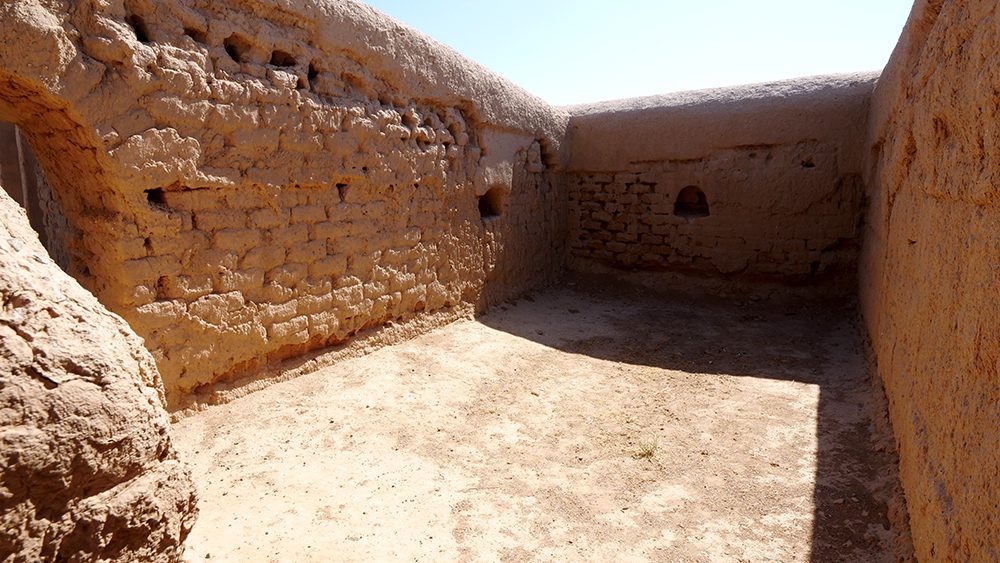
You have to get the watcher to open the gate to get inside to take a look around. It’s dark and cramped, but it’s worth the trouble. You can really feel the ancient history inside it.
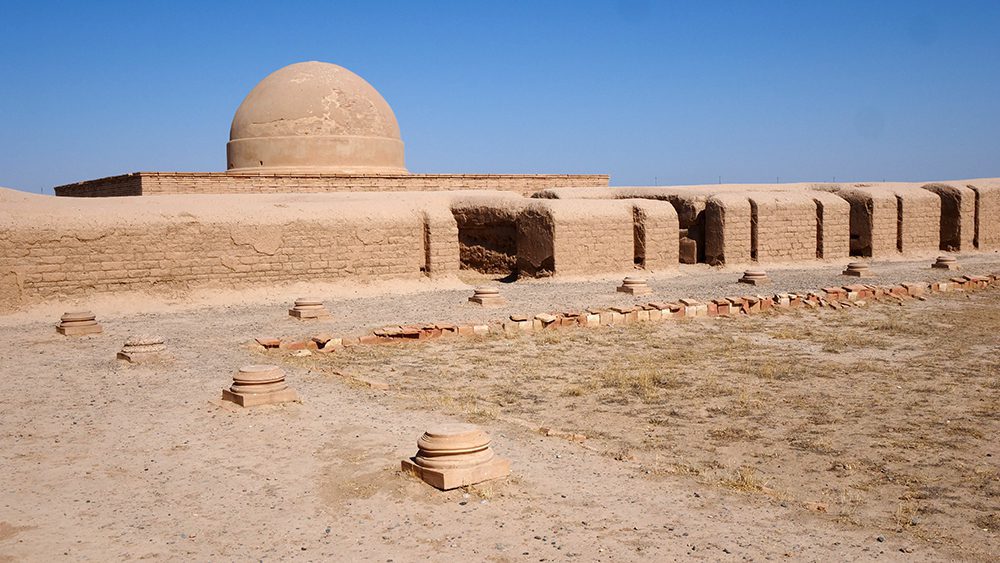
Elsewhere on the grounds, you’ll find the ruins of the monastery, which include what is left of the dormitories, kitchen, and sauna. You’ll find a central courtyard lined with pillars near the dormitories as well as the weathered remnants of the rooms.
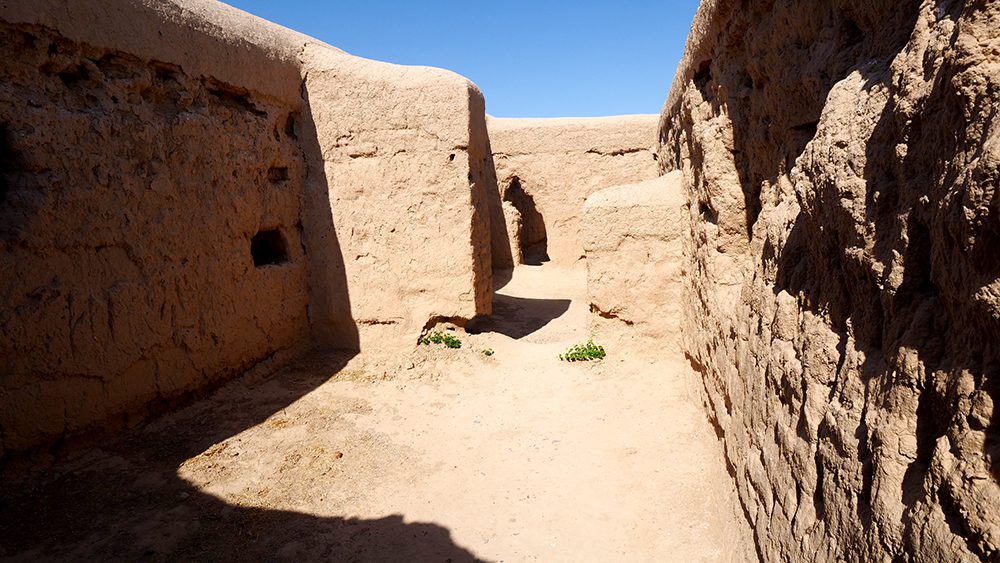
Each room has a small hole in a wall where they placed Buddha statues to pray to. However, I don’t advise touching anything. The walls of this site crumble at the slightest touch and have been deteriorating for a while due to exposure to the elements.

But even in its deteriorating state, it’s plain as day that this was a magnificent complex in its heyday. It’s larger than I had initially thought and is a dream to explore. The ruins of the sauna especially impressed me. The monks here used mud pipes to capture water from the nearby river to supply the sauna and complex as a whole.

It’s amazing what the ancient monks were able to accomplish here. If you love history as much as I do, visiting Fayaz-Tepe is easily one of the top things to see and do in Termez.

History is a huge draw to Termez, for sure, but that doesn’t mean they don’t also have incredible food there. One of the best spots in town to grab a delicious lunch is Rich Restaurant. The restaurant boasts a huge dining hall, but they also have smaller, private dining rooms as well. They’re perfect if, like me, you want to film without disturbing other diners.

There are a wonderful variety of salads on the menu, including a fresh, light one containing peas, cucumbers, olives, cheese, and tomatoes. You’ll also find the equally refreshing Achichuk salad, which is a staple around the country and contains juicy tomatoes; a dense, Manchego-like cheese; and onion.
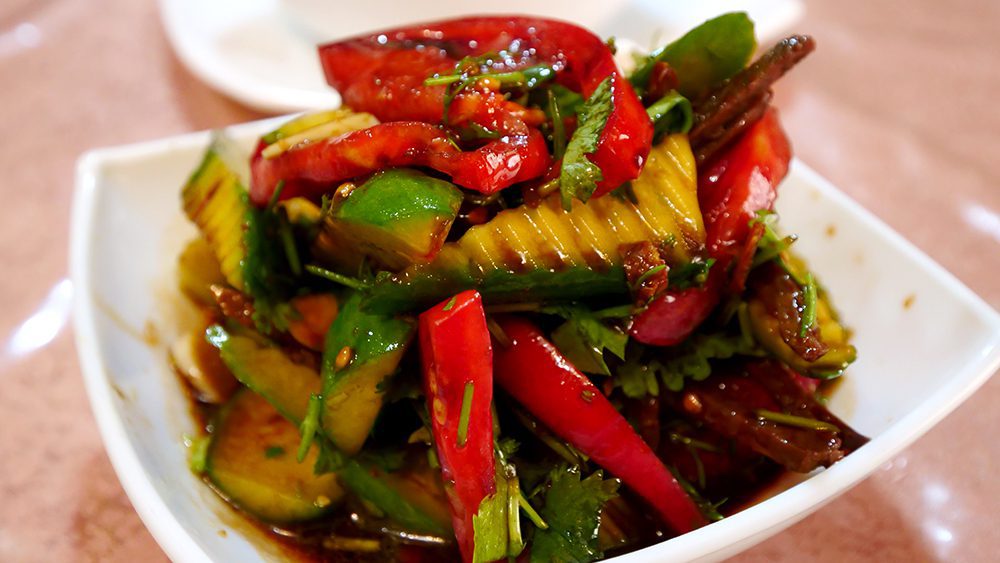
I also recommend the beef, tomato, and cucumber salad with soy-sauce-based dressing. But you can’t beat the buttery wild mushroom salad with beef and green onions. It is to die for!
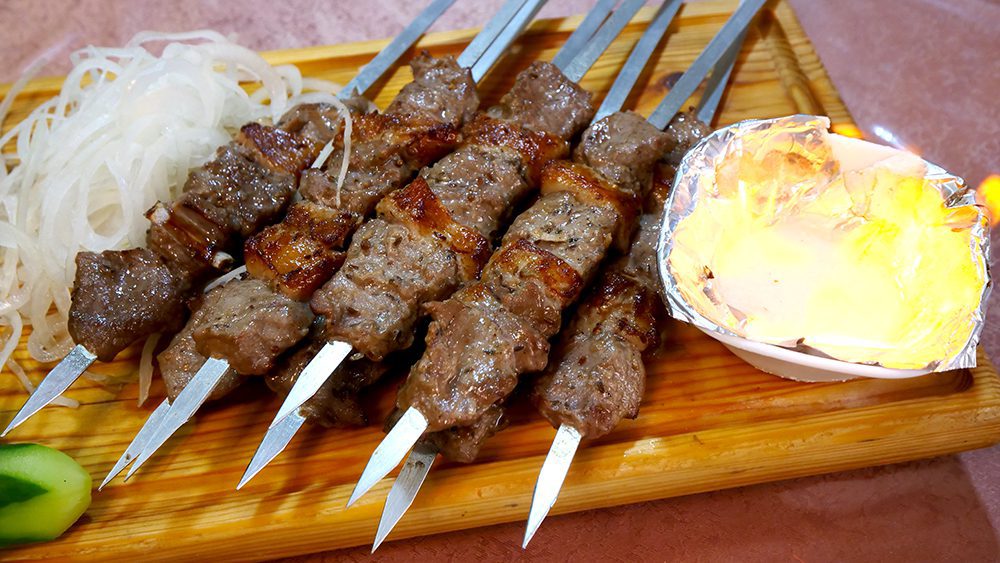
The lamb in Uzbekistan is on another level, so I highly recommend ordering a lamb kebab. They’re juicy and tender, with just enough of a charcoal crust on the outside to add an extra depth of flavor without it being burnt. They also serve fried lamb, which is fatty without being too crunchy and deep-fried.

I also recommend trying the mastava, a traditional soup containing beef, carrots, potatoes, tomatoes, and rice. The contrast of textures, combined with the flavorful broth, is beyond excellent. It’s the type of soup you’d eat to feel better when you’re sick.
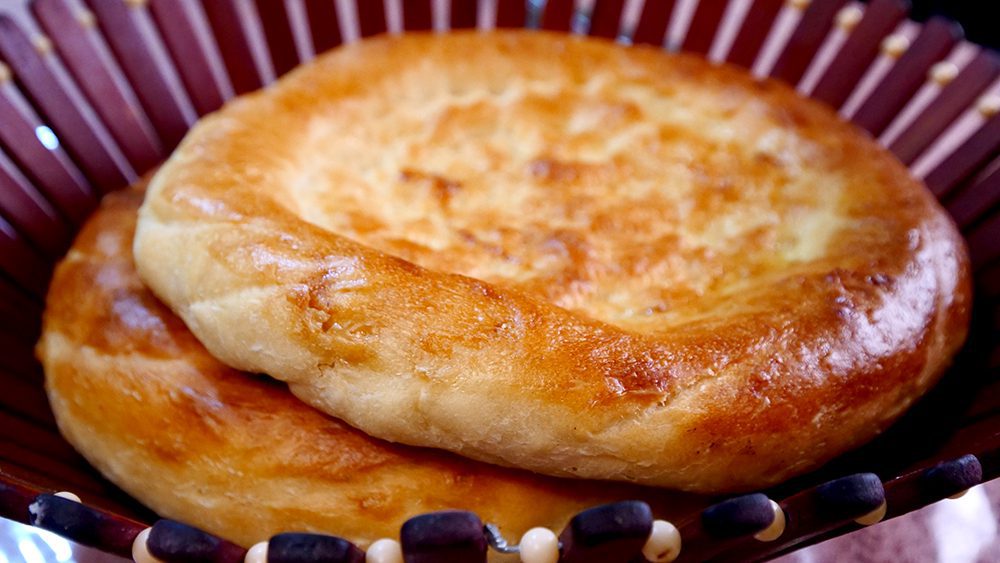
There are also several options to enjoy on the side, including freshly-baked Uzbek bread, which you can dip into the yogurt-like sour cream. Have a glass of fruity Uzbek wine on the side. The kind I had tasted like cherries! Then, finish up with some green tea. It’s known as Mountain Tea in Uzbekistan and is the perfect way to end your meal!
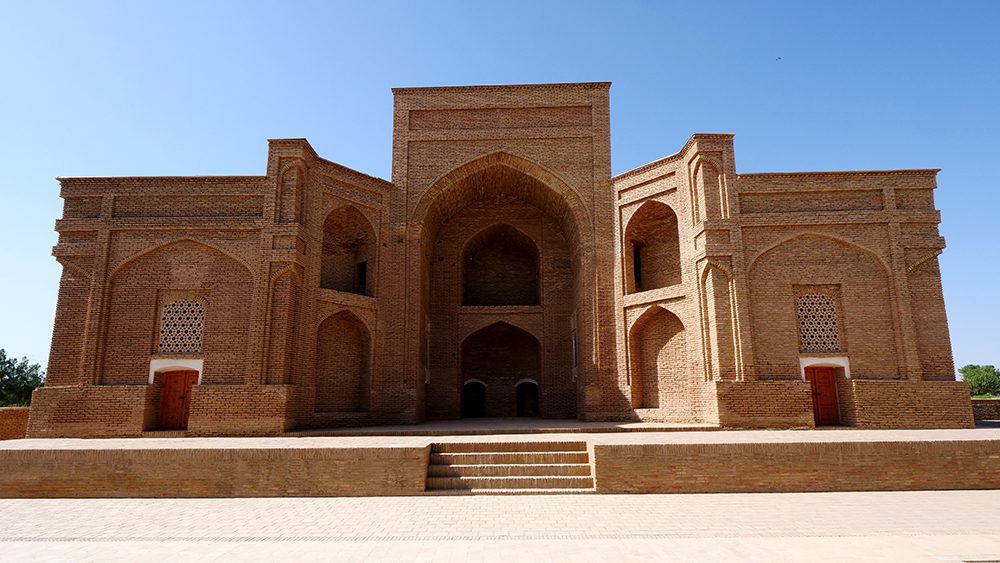
For sure, one of the top 15 things to see and do in Termez is visit the Sultan Saodat Complex. This complex of gorgeous, historical structures contains mausoleums, mosques, and a khanaqa. Khanaqas are buildings designed to be a sort of spiritual retreat for members of the Sufi brotherhood. Construction on the complex took place between the 11th and 17th centuries.
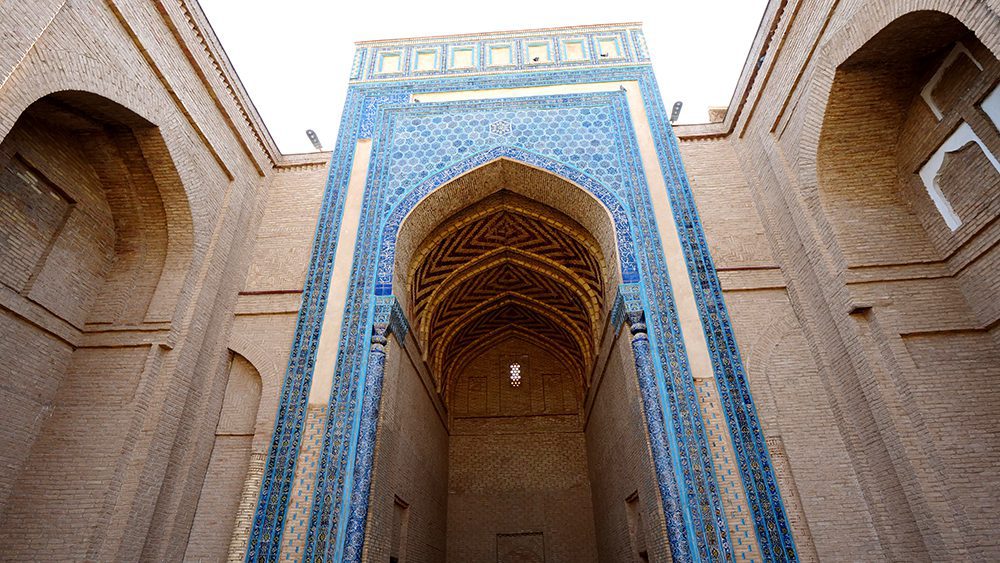
One thing that makes this complex so special, despite its aesthetic beauty, is that it is the final resting place of members of the Sayyid Dynasty of Termez. The members of this dynasty were descendants of Muhammad, the famous prophet.
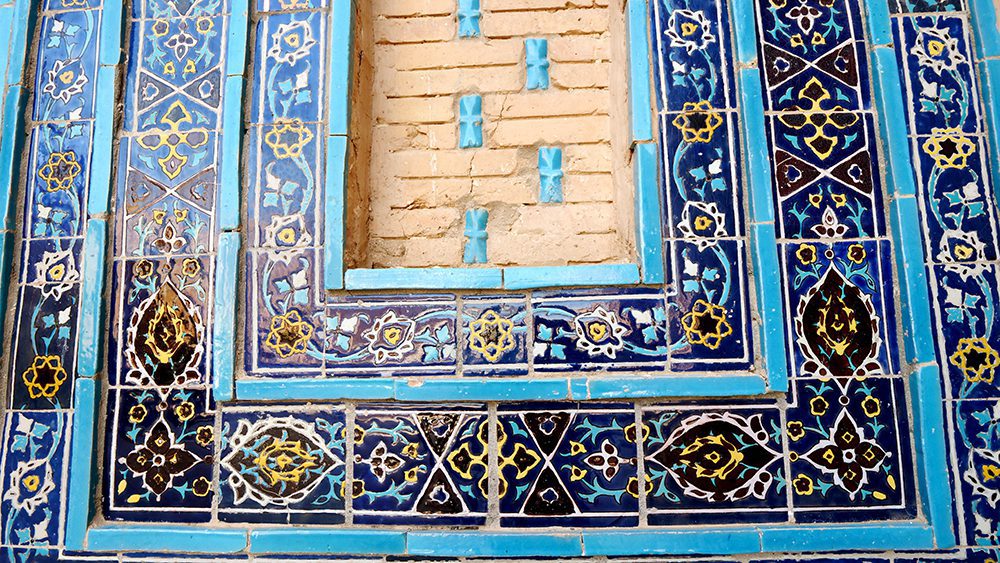
The crypt beneath the mausoleum’s dome is among the oldest parts of the complex. The people buried there were so influential that even Genghis Khan chose not to destroy the complex when he demolished the surrounding city.

Interestingly, though the complex was built during the Islamic Period, its architects added symbols from other religions, including Buddhism and Zoroastrianism.

There’s also lots of beautiful, very specific brick work that can only be found at Sultan Saodat Complex and Jakurgan Minaret. The stunning blue and aqua tilework was my favorite, though. I loved the way they contrasted with the white, aqua, and yellow designs.

I learned on my trip that Amir Timur, the first king of the Timurid Dynasty, loved blue. The color was meant to represent the sky, which is why so many mosques, mausoleums, and other important buildings around the country are adorned with blue tiles. You have to see this place for yourself. Photos don’t do it justice. You have to see its grandeur in person!

If you want so try some outstanding Uzbek food (or if you’d like a break from Uzbek food), check out Restaurant Dubai. They offer lots of different cuisines if you’d like to switch things up, but I only eat local fare when I travel so I can get a better sense of the culture and people. Having local Uzbek food is one of the best things to see and do in Termez!

The best thing to do here is to head up to their rooftop terrace with some friends and have a full-out Uzbek feast. You’ll likely start with some Uzbek vodka, and before you know it, you’ll have your pick of breads, soups, and salads. Break up the vodka with some fresh watermelon juice, which is sweet, pure, and really tasty!

The soups at Restaurant Dubai are fantastic. The galupsi contains sweet, stuffed peppers containing rice and beef. They’re huge and come submerged in a rich, tasty broth. The flavor profile and ingredients reminded me of something I’d eaten in Greece!

There’s another soup on the menu that contains lots of meat, fat, and small peppers that cook for eight hours in a mouthwatering vegetable broth. While the name of the soup escapes me, I cannot recommend it enough!
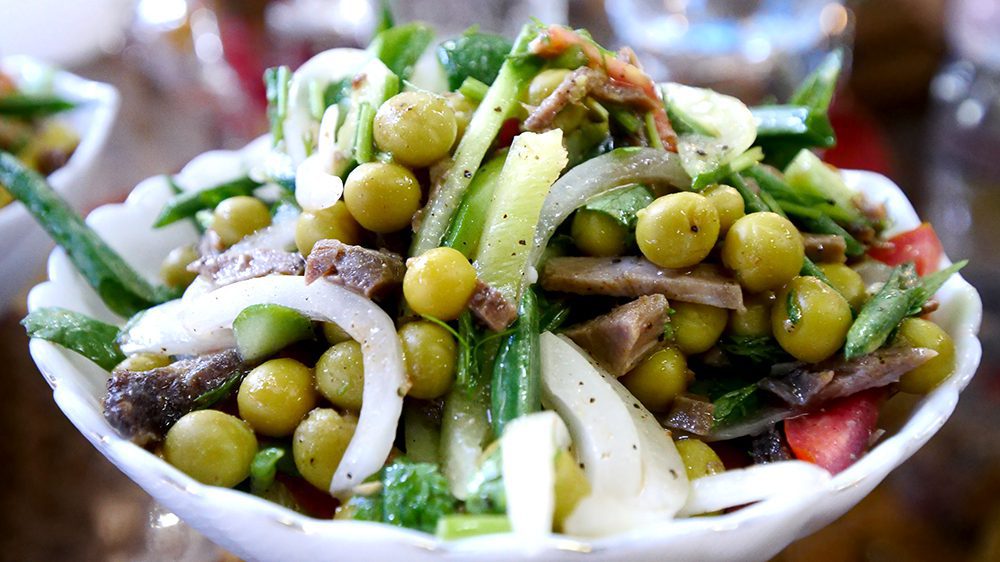
Also, try the chickpeas with beef. The beef is so so tender it’s almost soft and the dish comes with a huge hunk of beef fat that you break up into the soup. It was delicious, gelatinous goodness!
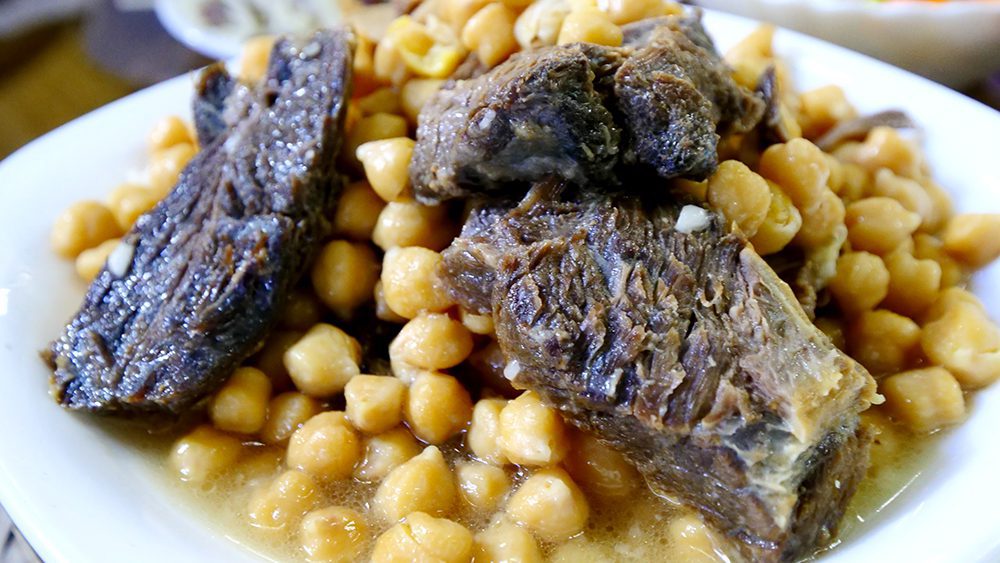
If you couldn’t tell already, meat is huge in Uzbek cuisine. In fact, there are very few dishes that don’t have meat in them. That includes the salads, which include a fresh and oily pea-cucumber salad and another that contains tomatoes, sausage, and more pieces of meat.

Last but not least, try the norin. Norin is a dish made up of horse meat and wheat pasta. I had originally tried this dish early in my trip in the capital city of Tashkent.
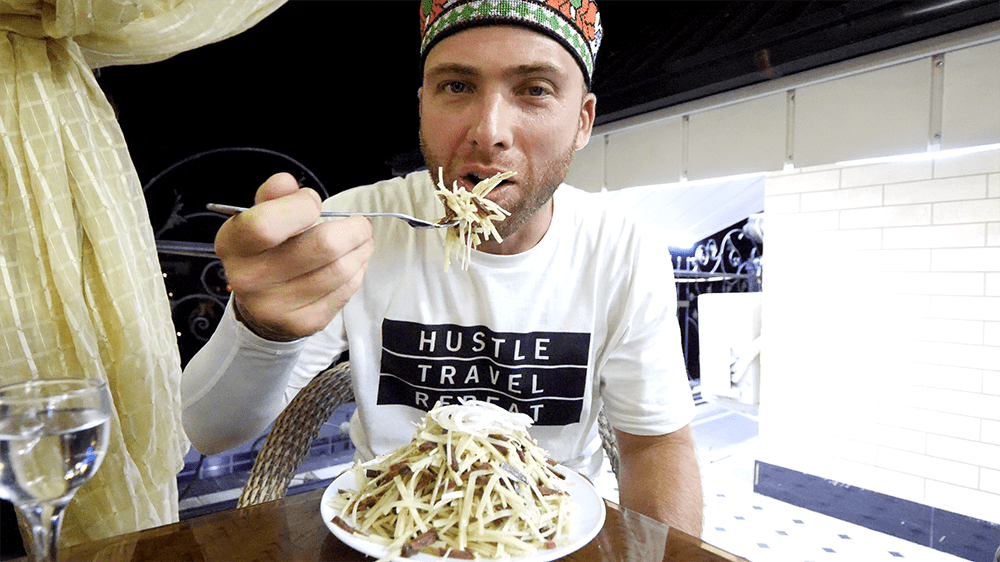
There, the pasta had had an almost cheesy flavor, but the kind at Restaurant Dubai had much more wheat flavor. It went very well with the gamy horse meat and I couldn’t help but shovel forkful after forkful into my mouth!
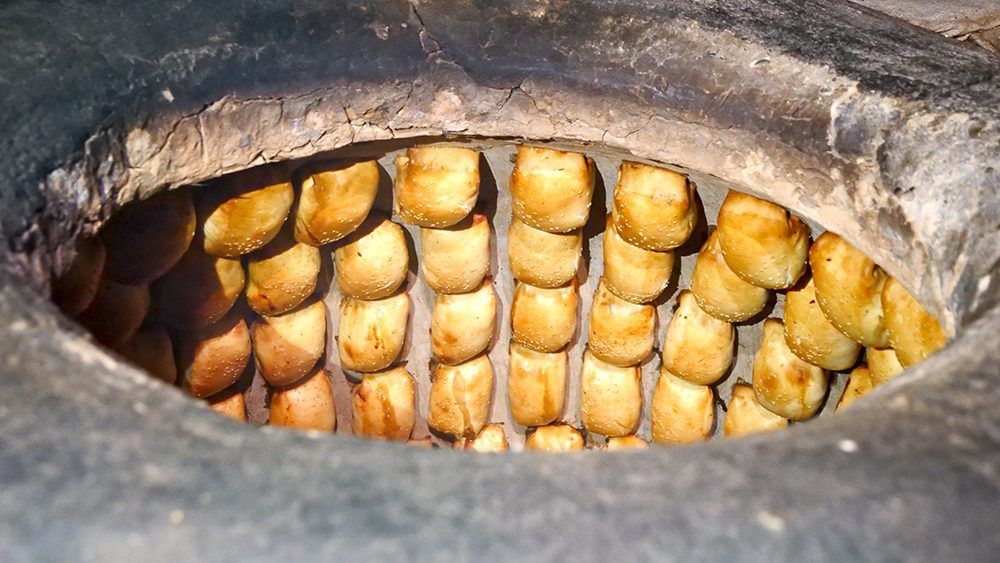
When you travel to any country, trying the most popular dishes among the locals is an absolute must. In Uzbekistan, there is no shortage of somsas, also known as samsas. These are savory, meat-filled pastries that are baked in a tandoor oven.
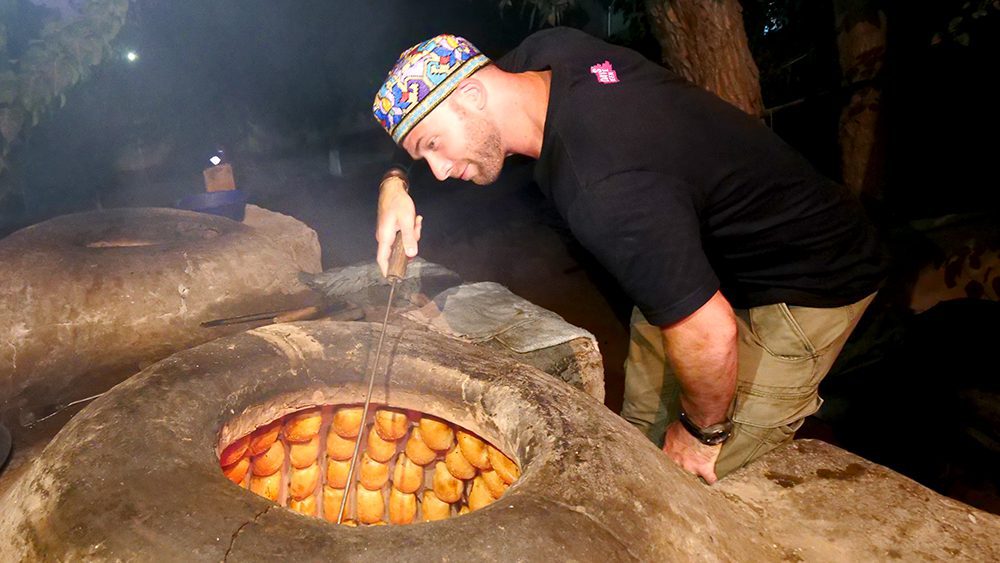
They’re always baked, unlike Indian samosas or the empanadas you can find throughout Latin America. There are slight regional differences, depending on which cities you try them in. And without question, one of the best things to see and do in Termez is eat somsas.

For amazing, high-quality somsas, head over to Sina Restaurant. The restaurant’s name comes from the town of Sina, where its owners are from. The town has its own somsa recipe, which they brought with them to Termez. And it is outstanding!
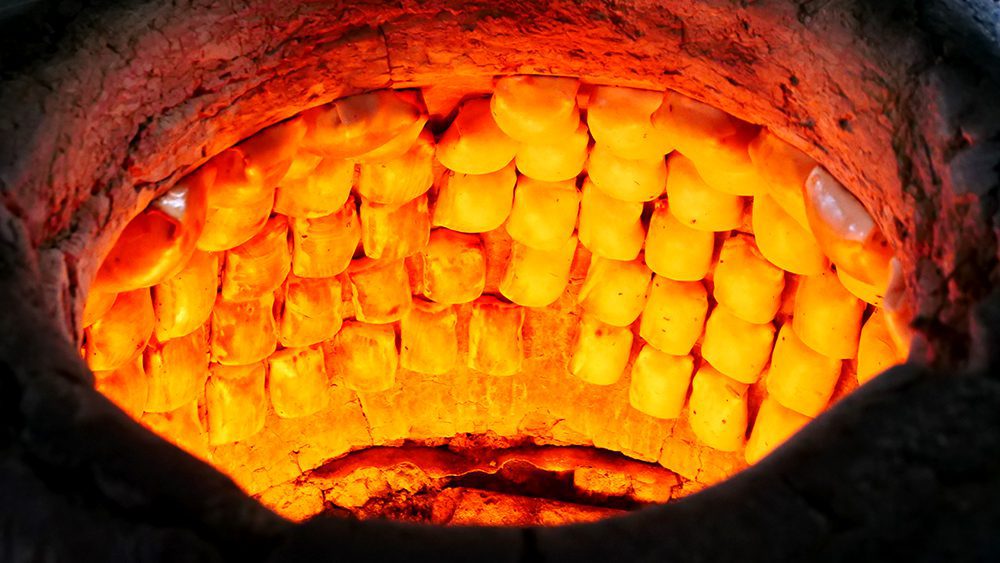
The somsas are perfectly cooked. They’re crunchy on the outside and contain a wonderful mix of beef, onions, and lamb fat. Open them up and add a spicy, gazpacho-like tomato sauce for an added kick of flavor!

Another regional variant of somsa can be found at Denov Somsa. This awesome Uzbek eatery is located in an open-air food court, so there are lots of other food and drink options in the vicinity. These somsas were particularly buttery and crunchy.

Like the ones at Sina Restaurant, they’re served with a spicy tomato sauce that pairs very nicely with the beef and onions inside. Trying these somsas with the tomato sauce is easily one of my favorite things to see and do in Termez!
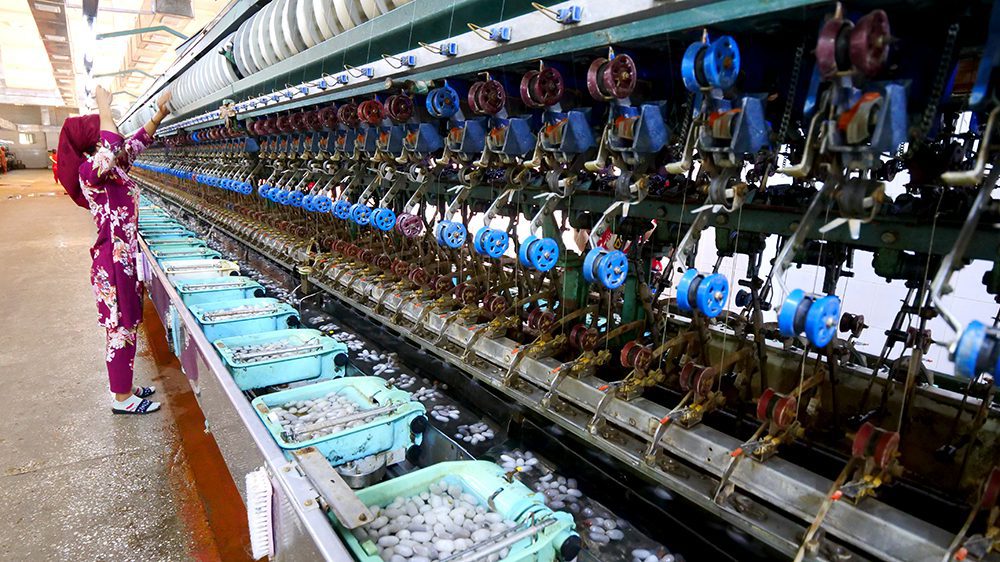
It may seem like a foregone conclusion for some, but something you absolutely must do while exploring this Silk Road country is visit a silk factory. There are many in Uzbekistan to choose from, but when you’re in Termez, I suggest Surxon Ipagi Silk Factory.
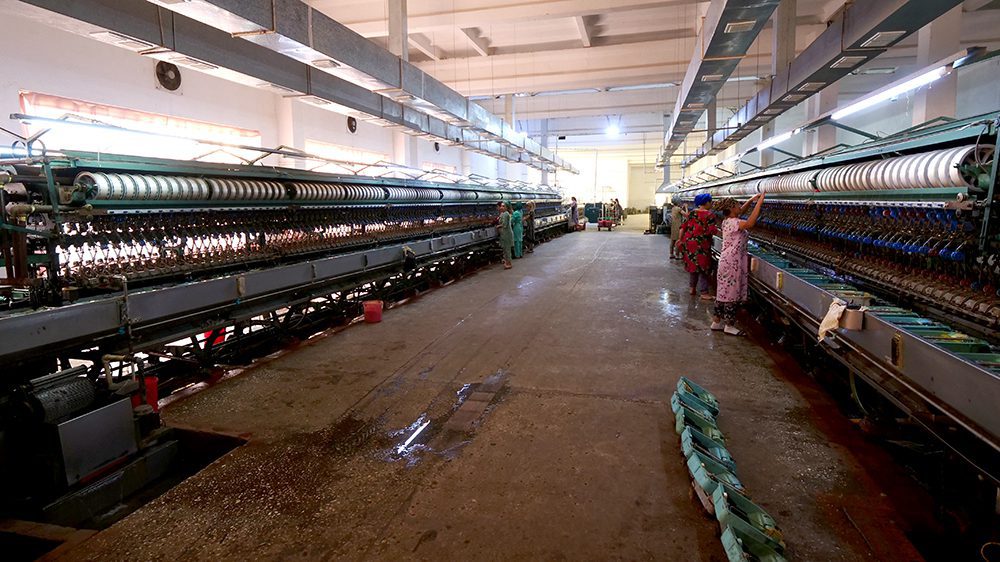
At this massive factory, you can watch as the workers pull silk from the cocoons. This factory alone produces roughly 10,000 kilometers of silk daily and 10 tons of silk fiber in a month. They also have over 1,200 rolls of silk there, and each of them contains 8 kilometers of silk.
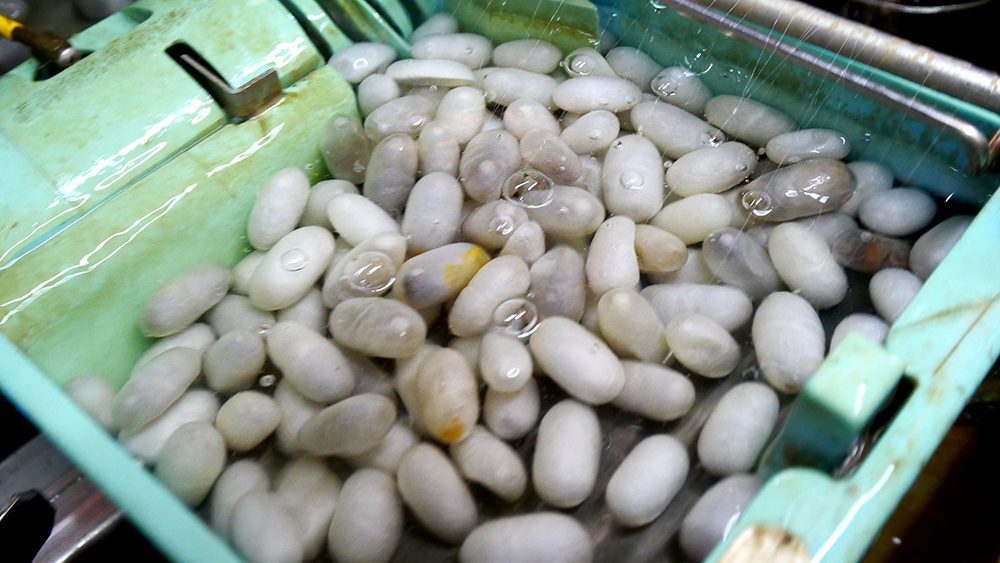
I suggest taking a tour of the facility to see the entire silk-making process. The silk produced here is local, as the cocoons are harvested from nearby villages. After they’re brought to the warehouses, dried, sorted, separated, and cleaned, the silk is pulled onto a roll.

Five rolls make one band of 40 kilometers of silk, and after some additional cleaning and pressing, they’re sent to other shops to produce silk products.

The products created are then sent back to the facility’s silk shop to go up for sale. Most of the products there are for women and include beautiful and inexpensive silk scarves. They only cost about 100,000 Uzbek som each, or about $10 USD.

It’s some of the most inexpensive silk I’ve ever seen in all of my travels. It’s the perfect place to buy luxurious gifts that won’t break the bank!
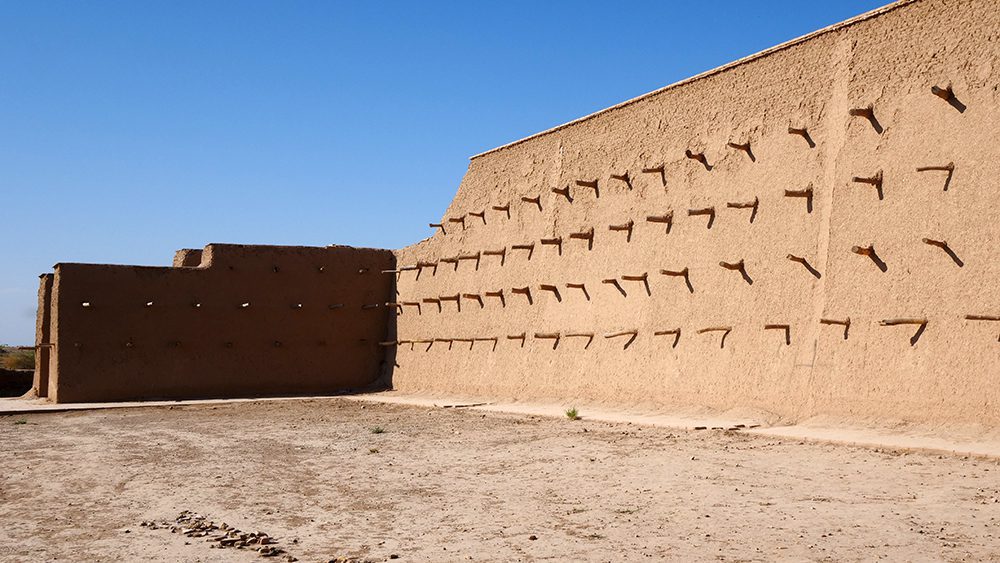
Roughly a two-minute drive from the ancient Buddhist monastery of Kara-Tepe is yet another fantastic relic from the past, an authentic Silk Road Gate. This gate was the first that traders and travelers would pass through after they crossed the Amu-Darya River from what is now present-day Afghanistan.
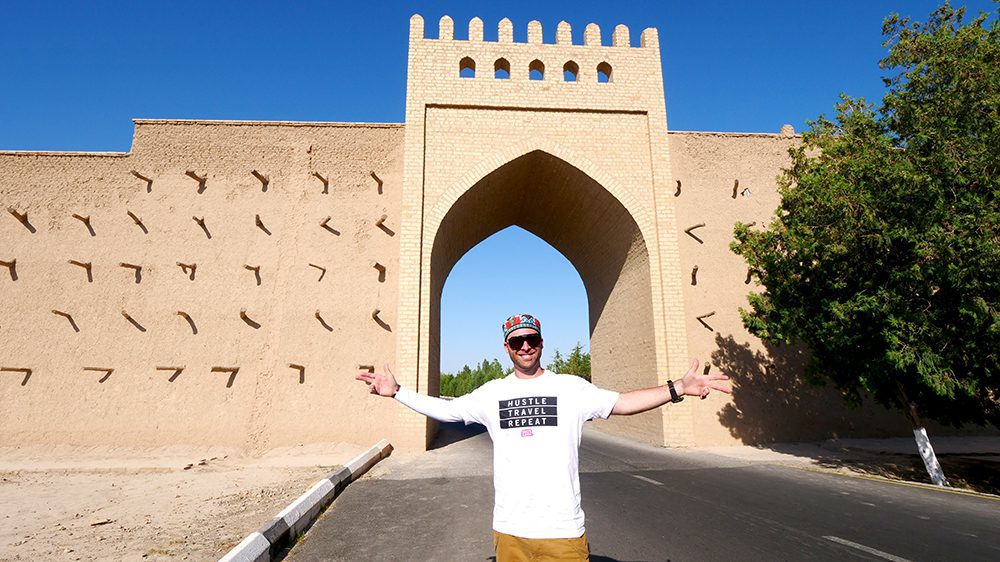
The gate itself has clearly been restored, as its walls are in exceptional condition for such an old structure. It’s now used as a customs gate. I’ve visited lots of forts around the world in my travels, but this gate reminded me more of fortifications I had explored in Europe.

The only downside I found is that someone had climbed to the top of the wall and tagged it with graffiti, creating a blemish on an otherwise pristine gate.

While the history, and the idea of famed explorers passing through the gate, make it one of the top things to see and do in Termez, also come for the view. From atop the wall, you can see the Amu-Darya River, Afghan lands in the distance, as well as the nearby site of Al Hakim At-Termezi!

Because Uzbekistan was part of the Soviet Union from 1925 to 1991, lots of Soviet influences can still be found around the country. One area impacted by Soviet control is its cuisine. If you’d like to try some Soviet-style food in Termez, head over to Café Bistro Restaurant.

There, you can enjoy a Soviet-style breakfast consisting of boiled chicken, pasta with meat, sausages, egg, and more. You can also have traditional Uzbek dishes like somsas and fried dough. I suggest trying a mix of both cuisines to get a true taste of this country and all of its influences.
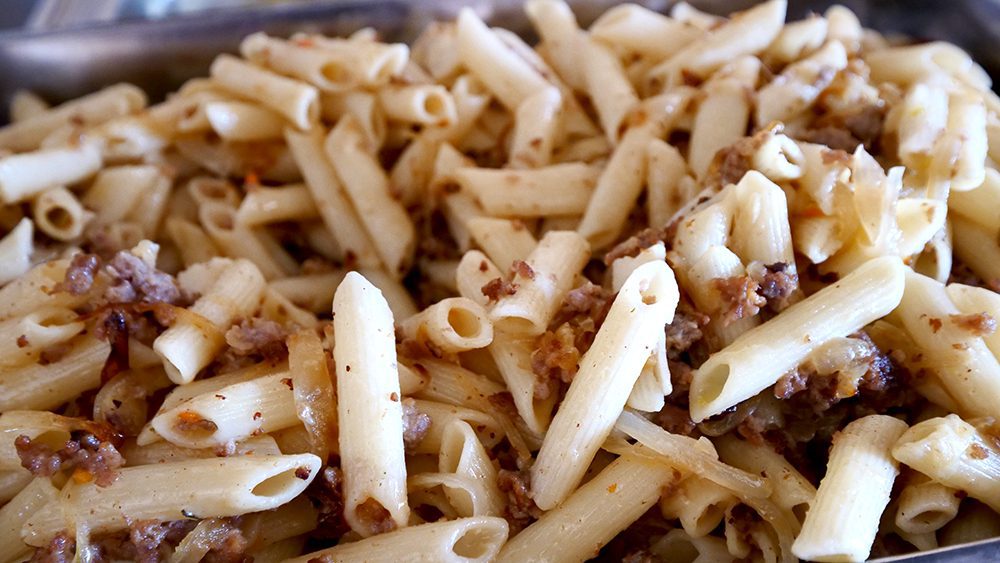
The pumpkin-and-onion-filled somsas are particularly delicious. They were like having pumpkin pie inside an empanada. There was also a sweet but watery and milky oatmeal that was very different from the oatmeal I’m used to in the States. It’s full of cardamom flavor and is quite tasty.
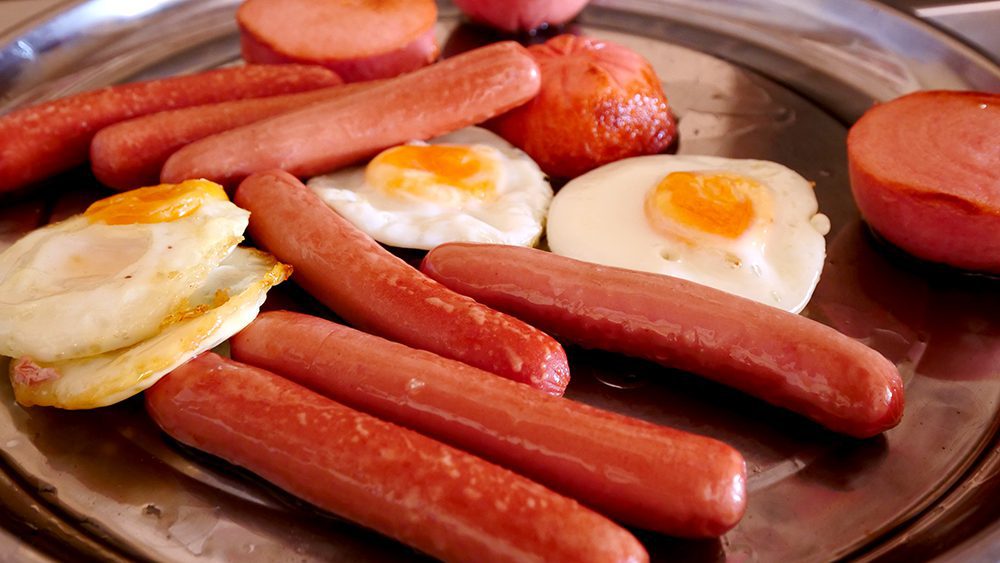
I also suggest diving into the beef and onion penne pasta, as well as the rice drizzled with an earthy, mushroom-like gravy. There are also some tender beef strips, but while the eggs were tasty, their yolks were a bit too overcooked for my liking. You can also try a massive sausage slice, which is far too big for just one person!

I recommend trying a bite or two of everything and then mixing everything on your plate together. The earthy gravy ties all of the flavors together and elevates them all. And while I can’t place this Soviet breakfast among my favorite breakfasts ever, trying it is still one of the better things to see and do in Termez.

During my final few hours in Termez, I wanted to do something a bit unconventional. My guide, Otabek, told me about a wedding ceremony going on in town, and the next thing I know, we headed over to Afruz, a large venue that holds events in town, and crashed the ceremony!

Unlike in America, where wedding crashing is considered rude and frowned upon, I found it to be the opposite in Uzbekistan. The guests there were extremely friendly and were happy to share food and drinks with me. The spread was pretty fantastic and included salads, bread, somsas, pistachios, and chocolate! We also enjoyed a couple of vodka shots together.

I arrived at the wedding about an hour before it kicked off. Unfortunately, I didn’t have time to stay for the whole thing as I had to catch my flight back to Termez. But the time I spent there was very memorable and I highly recommend attending an Uzbek wedding when you’re in Termez!
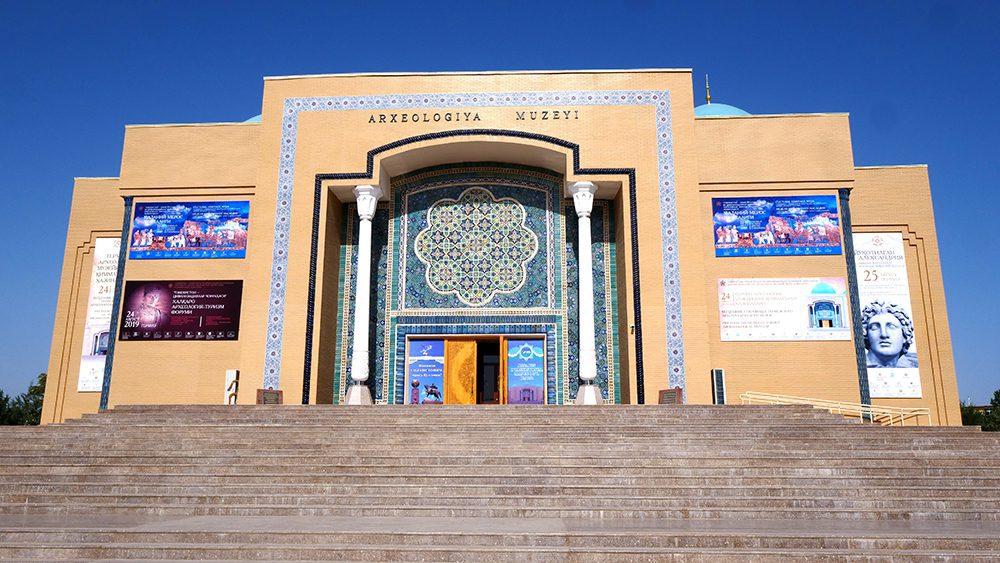
As a major history and archaeology buff, my list of things to see and do in Termez had to include a stop at the Archaeological Museum of Termez. This museum, which focuses mostly on the Graeco-Bactrian and Kushan eras, opened on the 2,500th anniversary of Termez in 2002.

The building’s exterior may look more like a mosque than a museum, but inside you’ll find over 40,000 antiques from the Bronze Age all the way up to the 15th century!
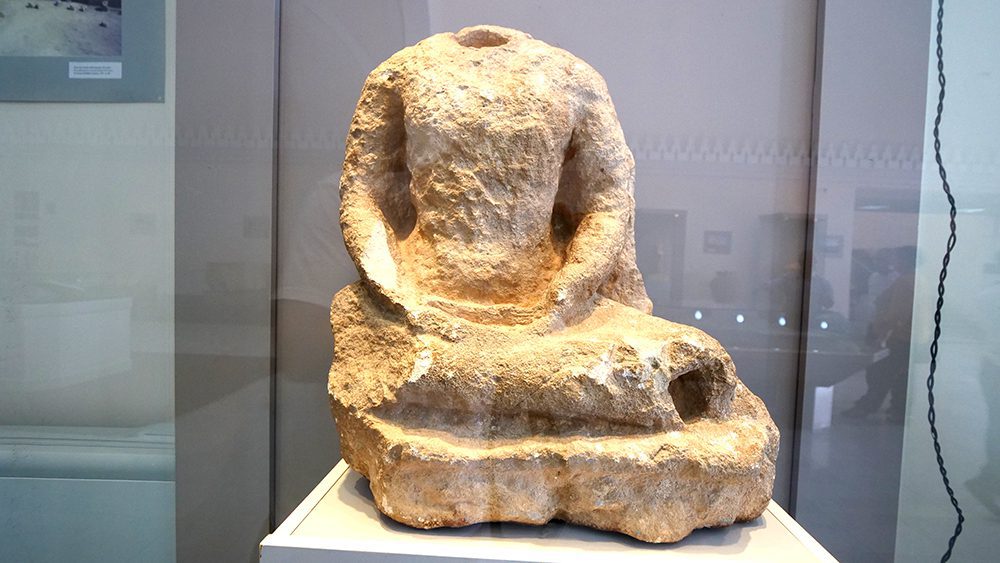
On the ground floor, you’ll find a helpful map of the Surxondaryo Region, as well as an 11th-century vase, a bathtub from the 4th century BC. I couldn’t help but marvel at the pottery and statues there, as well as a stone stele of writing from the Koran.
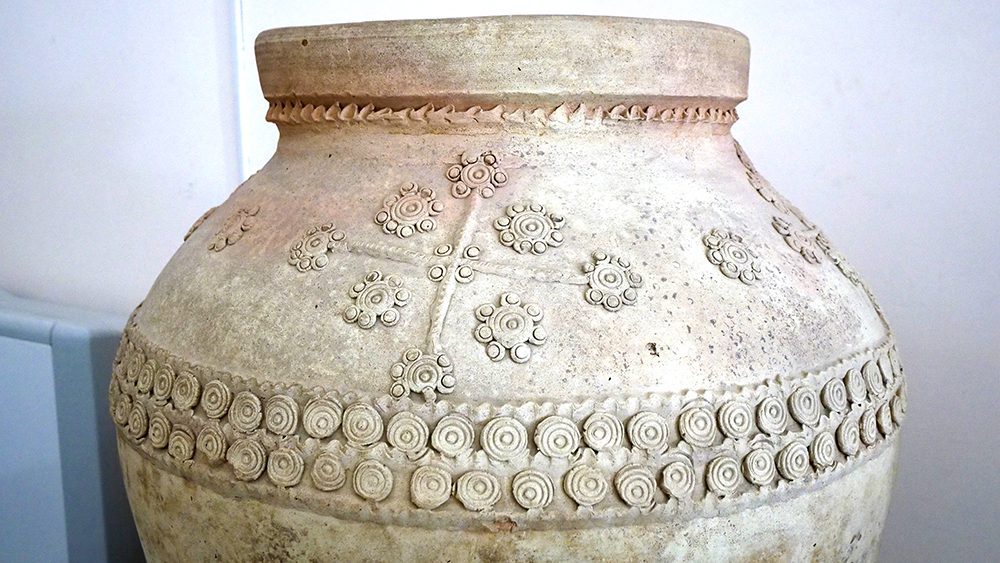
If the first level is impressive, it’s nothing compared to what awaits visitors on the second floor. You’ll find more pottery sherds there, as well as tools, weapons, and paintings. Bones belonging to an ancient Uzbek can also be seen, as well as 10th-century ceramic water pipes, vases, bells, and coins.

You’ll also find other ceramic work from the 9th-12th centuries and an ancient version of the folding, wooden book stands I had seen in markets in Khiva and Bukhara. The items are quite colorful and beautiful to look at.

But the cornerstone of the second floor is the exhibition hall dedicated to Alexander III of Macedon, better known as Alexander the Great.

During the ancient king and military commander’s reign from 336-323 BC, he became arguably the most successful commander in history. And during that time, he passed through the Termez area as he made his way from Macedonia.

Among the exhibits in his dedicated section are a detailed model of a city he built in what is now Uzbekistan named Kampyrtepa. The model shows minute details about the city. I could even see the way the city was set up so that the rich lived inside the city walls, while the poor were relegated to outside of them.

The Archaeological Museum of Termez is easily one of the top things to see and do in Termez. I visited it on my last day in the city, but I suggest checking it out first. Seeing the museum first will give you added context that will allow you to further understand the archaeological sites you’ll likely visit later.

As you explore the millenias-old sites of Old Termez, be sure to check out its northwestern sector. There, you’ll find another of my favorite things to see and do in Termez, Kara-Tepe.

Kara-Tepe is an ancient Buddhist monastery built in the early 2nd century AD. The monastery consists of both buildings made of pahsa and unbaked brick, as well as caves cut into quaternary sandstone. Kara-Tepe reached its heights in the 2nd and 3rd centuries, but some of its shrines fell into disuse by the 4th and 5th centuries.
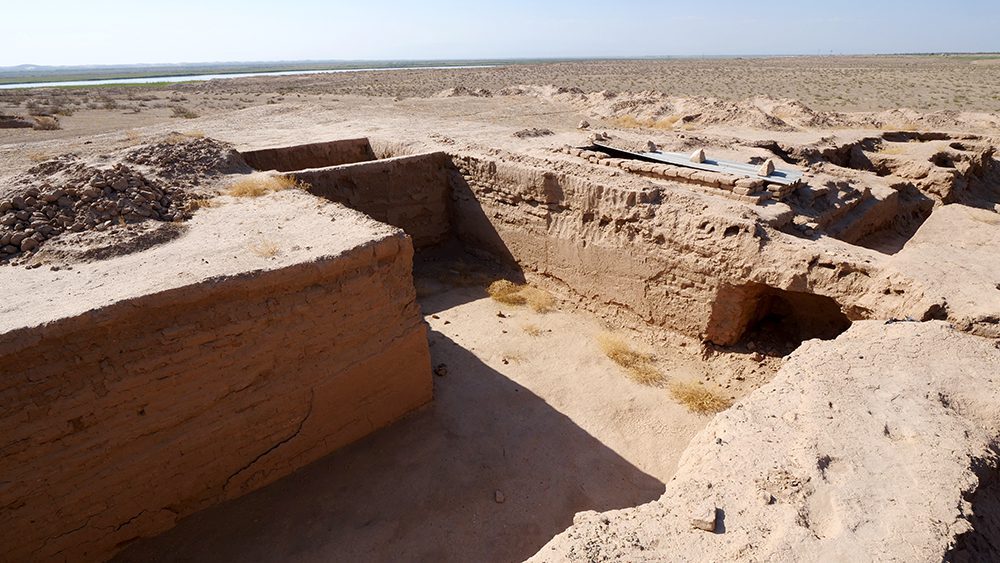
It is believed to have still functioned until the 6th century, after which some believe the local Buddhists, forced out by Arab invaders, resettled in what is now Kashmir.

Structurally, the site reminded me of Fayaz-Tepe. It boasted high walls and large rooms, as well as a terrace. Like at Fayaz-Tepe, the walls here crumble just from you touching them or brushing past them, so be careful as you explore the many rooms and corridors.

Unlike archaeological sites I’d visited in Europe, no one was on-site, though part of the monastery was covered by a tent to protect it from the elements.
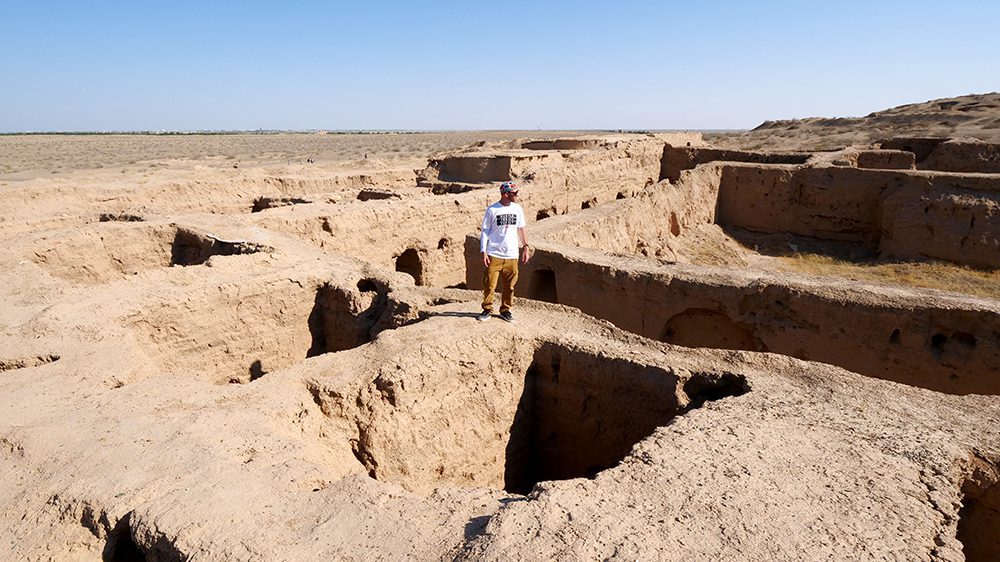
From Kara-Tepe, you’ll also enjoy beautiful views of the Amu-Darya River and Afghanistan on its opposite bank. Whether you’re into history or not, this site should be on everyone’s list of things to see and do in Termez.

To visit Termez’s holiest site, you’ll have to check out the Al-Hakim Al-Termezi. Named after Termez’s patron saint, Al-Hakim, this 15th-century complex used to be a mosque. It’s surrounded by a lush, green garden featuring lots of trees and vibrant flowers. The greenery attracts lots of flies and dragonflies.
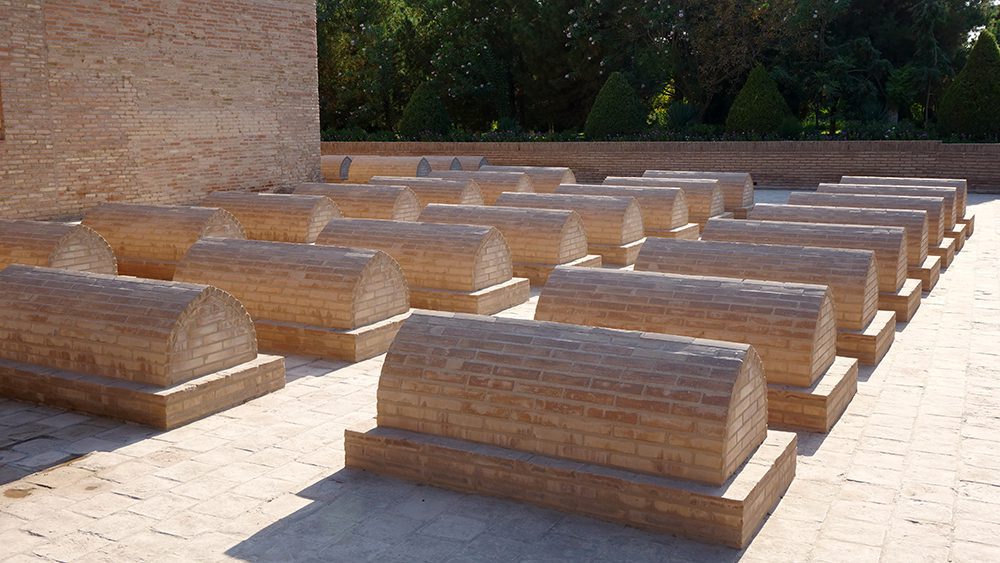
On the site is the Mausoleum of Al-Hakim Al-Termezi. It was built between the 10th and 15th centuries, though graves from the 17th-19th centuries can be seen outside. Al-Hakim, also an author and scholar, was considered one of the most important figures in Islamic history.

The interior of his mausoleum, with its white marble walls and intricate blue-and-gold designs, is fitting for a man of his stature and influence.
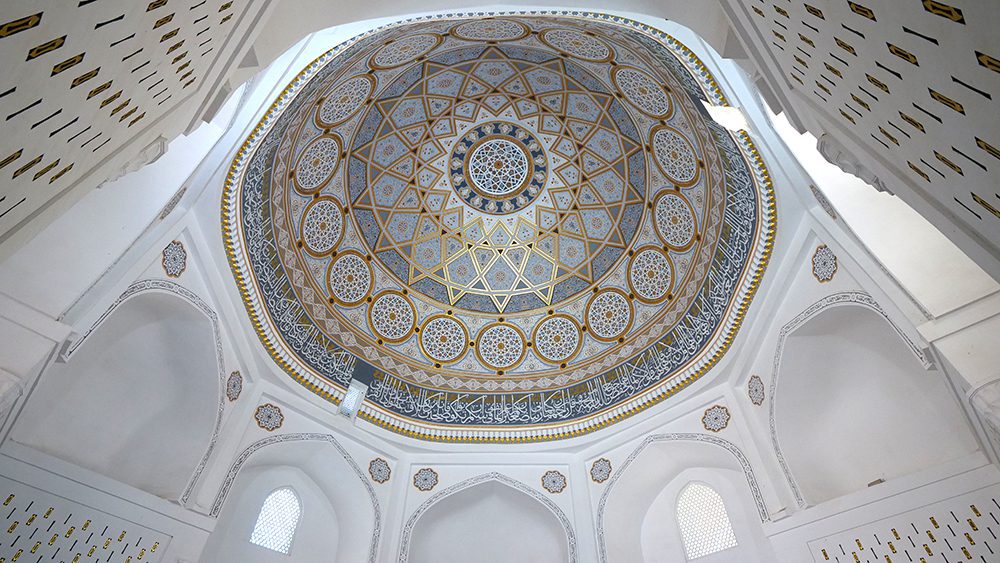
I also really liked the scripture from the Koran, which adorns the walls. The tomb was larger and wider than others I had seen on my trip.

Another interesting feature of Al-Hakim Al-Termezi is the cave system outside. People venture inside to pray. It’s also a good spot to beat the Uzbek heat, as it’s at least 20 or 30 degrees cooler in there!
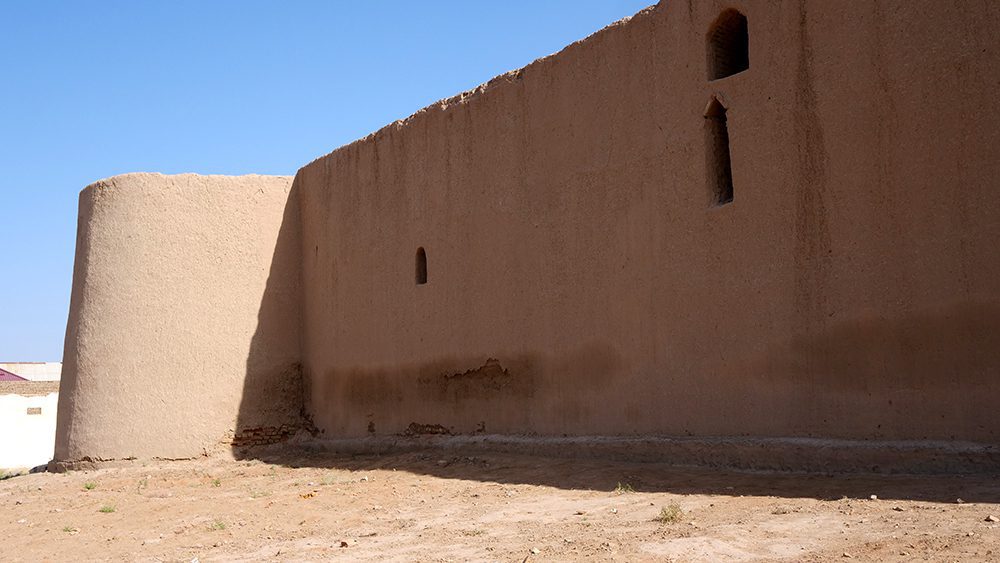
Another of the top things to see and do in Termez is visit Kirk Kiz. As stunning as its 11th-century ruins are, one of the most interesting things about it is that researchers don’t agree on what its purpose was.

Archaeologists have excavated the site since 2016, but some believe it was a palace, while others think it served as an abbey, a caravanserai, or a fortress.

The square-shaped complex is 54 meters long on each side and made of raw brick. Because its four corners were guarded by towers, it looked more like a fortress to me. There’s even a local legend that 40 women, under the leadership of a princess named Gulaim, fought off nomadic raiders from the safety of the complex.

Inside the complex are a 15-room residency and an open-air central courtyard. Archaeologists also disagree on whether or not the courtyard was once covered by a dome. Much of the building is in ruins, but it somehow doesn’t take away from its grandeur.

Also on the grounds is a wish tree, where visiting women tie cloths around its branches so God will grand their wishes. Whether you choose to make a wish or not, visiting Kirk Kiz fortress is among the top things to see and do in Termez.
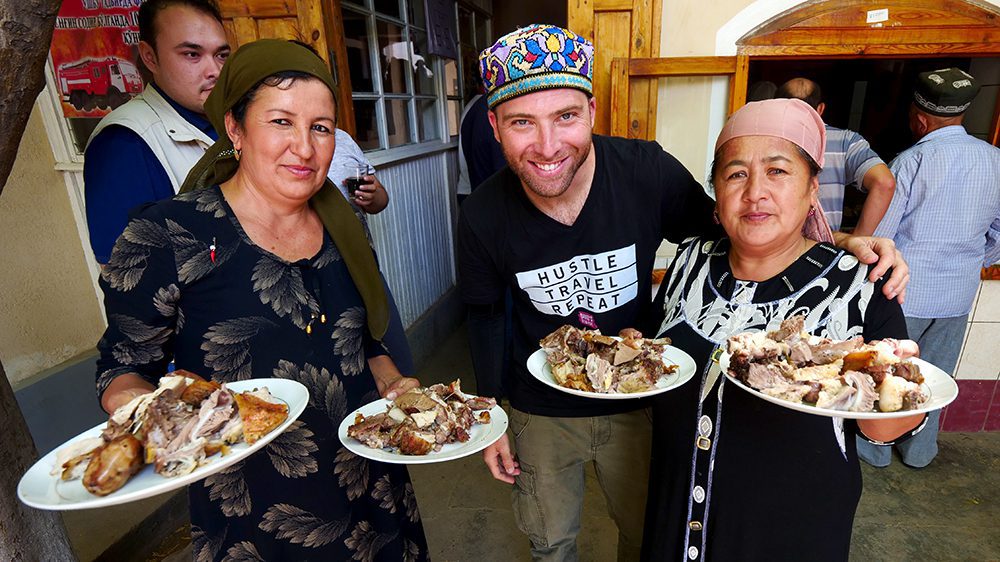
One of my favorite types of meat in the world is lamb. My wife is Greek, so we have it at least one a week at my house. So, when I say some of the best lamb in the world is in Uzbekistan, I mean it, 100%. More specificially, you’ll find it in a non-descript restaurant that looks more like someone’s home in the town of Jarkurgan.
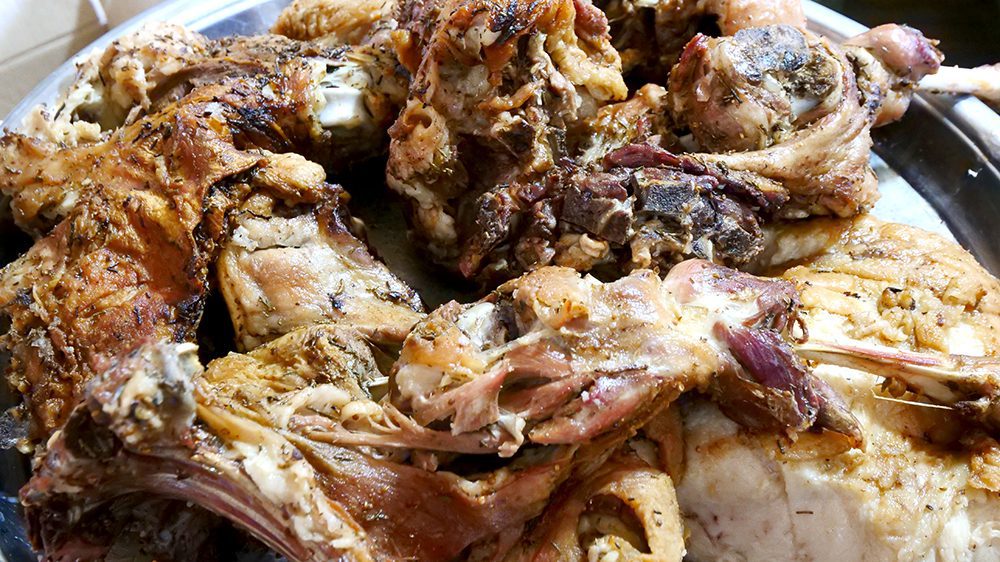
It’s a hidden gem roughly 30 minutes outside of Termez. The tandoori lamb here is out of this world! You can smell it before you even go inside. Just getting a whiff of it is one of the best things to see and do in Termez!
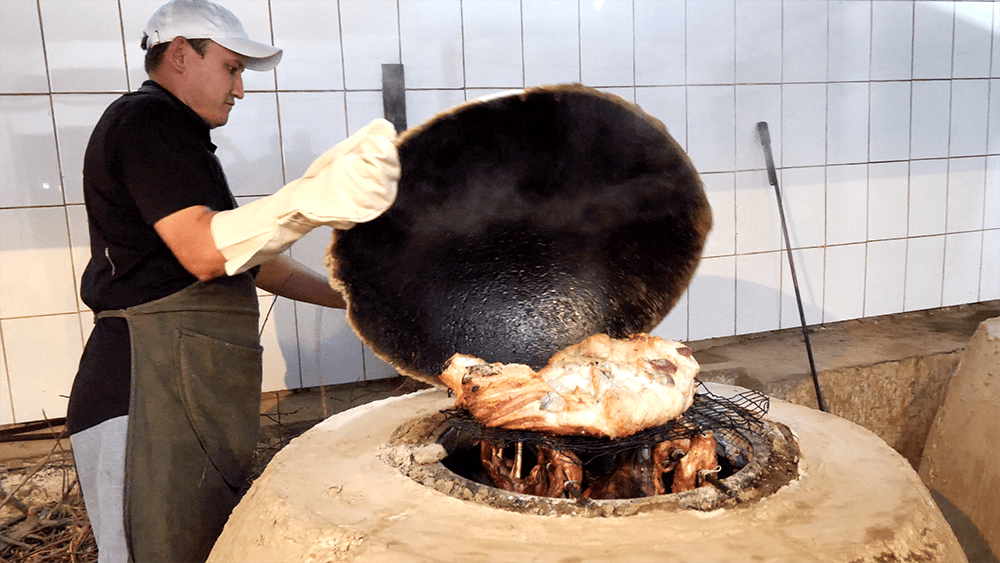
After the lamb is salted and rests for 30 minutes, it’s placed inside a traditional clay oven called a tandoor. The legs go inside first, followed by a large slab of meat from the body. It’s then covered with a large piece of fat.

The lid is placed on top and sealed with mud. Eighty minutes later, the lamb comes out crispy, tender, juicy, and smoky.
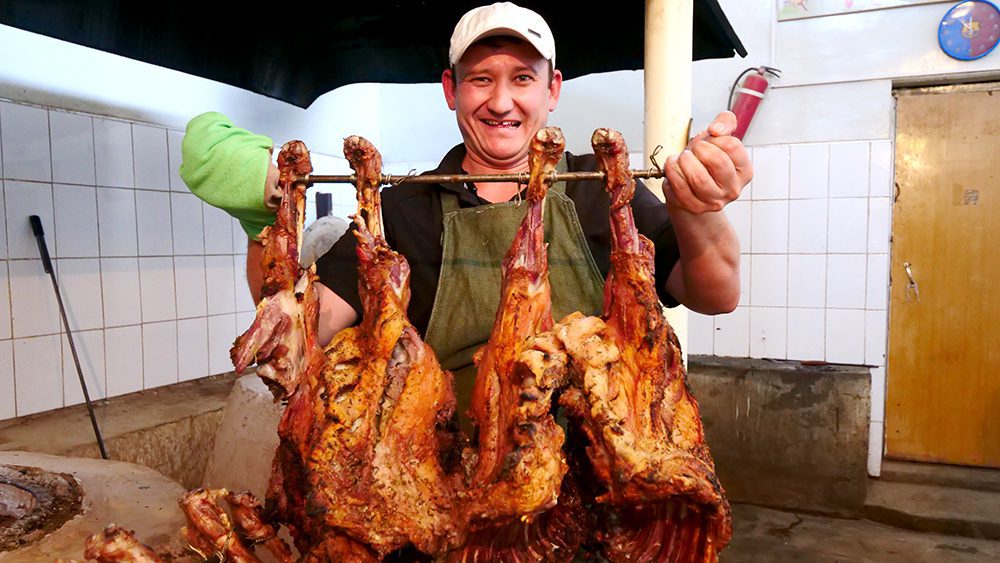
Whether you prefer lamb shoulder, chops, ribs, legs, or innards, you won’t be disappointed here, as they have it all. You won’t need a fork and knife for this feast. Instead, do as the locals do and dig in with your hands!

The meat on the legs and chops is so tender, it falls off the bone at the slightest touch. The crispy, roasted outside gives the lamb added, pork-rind-like texture. When you get a bit of that crispy skin with the tender meat and gelatinous fat in one bite, it’s like lamb heaven in your mouth! It’s both gamy and undeniably fresh and organic and had my mouth watering the entire time.

While the meat is great, I also suggest trying the innards. The liver is so soft and buttery that it practically disintegrates the moment it touches your tongue. It’s full of sensational, iron-rich flavor and was a major highlight of my meal. Don’t forget the kidneys, too, which have a similar flavor, though they’re a bit more dense.
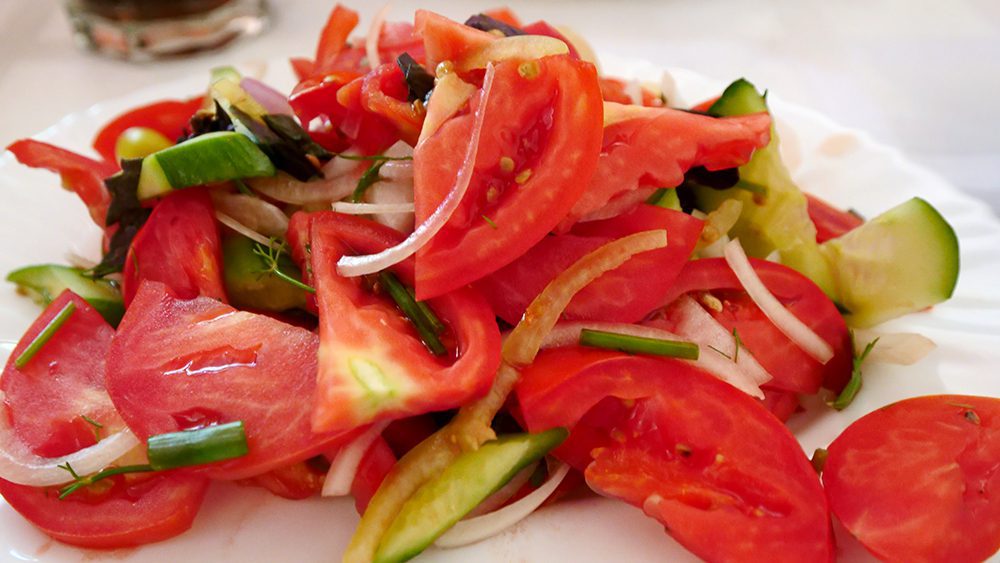
To break up the heavy fattiness of the meal, enjoy an Achichuk salad on the side. The tomatoes, cucumber, and onions in it are the perfect pairing for the meat. As with all Uzbek meals, you’ll also have bread, which you dip into the sour cream. The sour cream is more like a thick, sour yogurt. I recommend taking some of the lamb meat and fat and eating it with the bread!
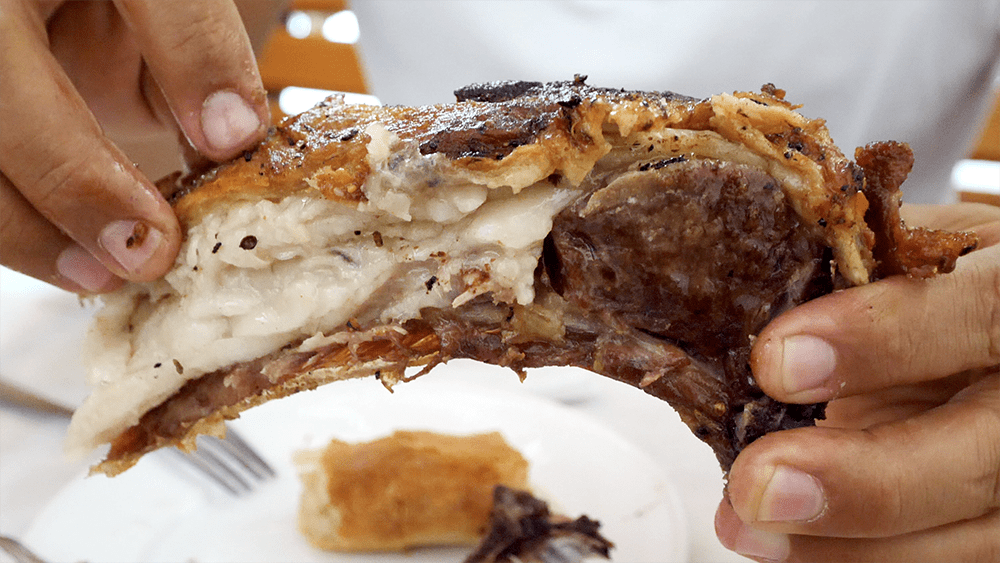
The meal is also very inexpensive at just $11 USD for one kilo. I had several people from the local tourism department with me, so we ordered 2.5 kilos in total. At less than $30 USD, it was practically a steal!

If you haven’t guessed it already, this was one of my absolute favorite things to see and do in Termez. I couldn’t get enough of this lamb and neither will you!
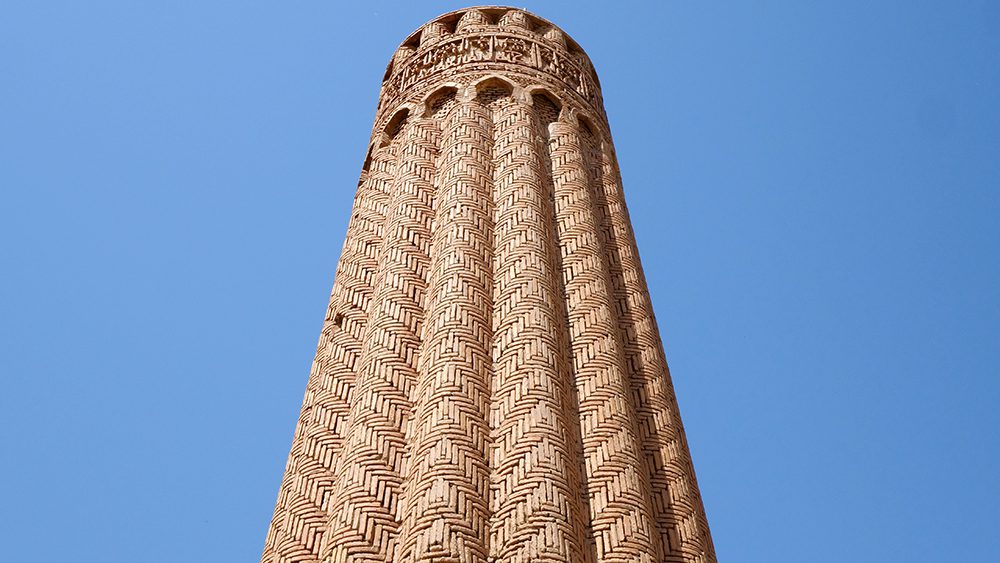
A little over four miles outside the charming town of Jakurgan is the area’s most famous landmark, Jarkurgan Minaret. Built between 1107 and 1109 by the architect Ali ibn Muhammad Serakhsi, it is the oldest minaret in Central Asia.
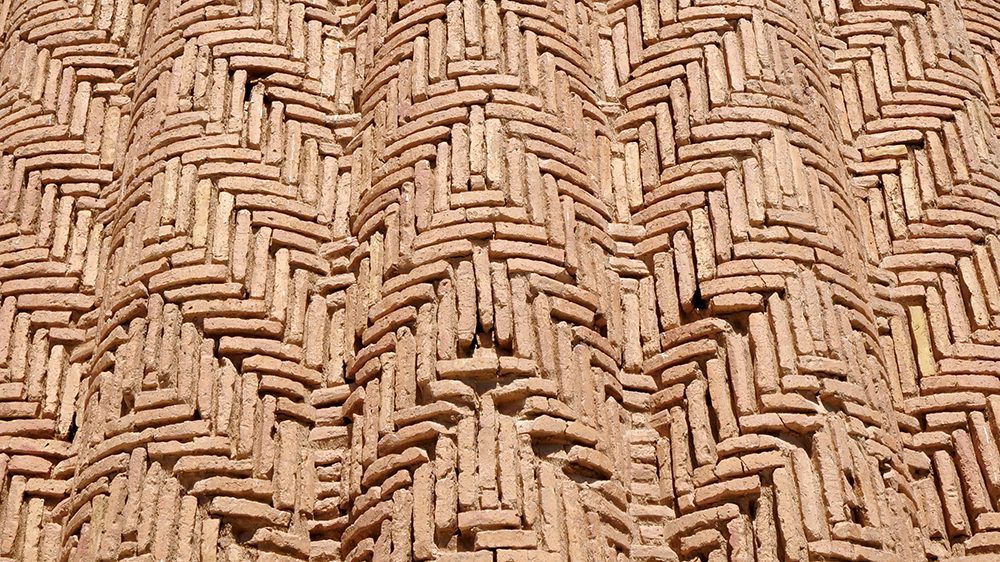
The minaret that stands today is only a fraction of its former self. Though the tower was originally over 160 feet tall, only its lower 72 feet remain. During my visit, I learned that a large mosque once stood nearby, but it too was destroyed.
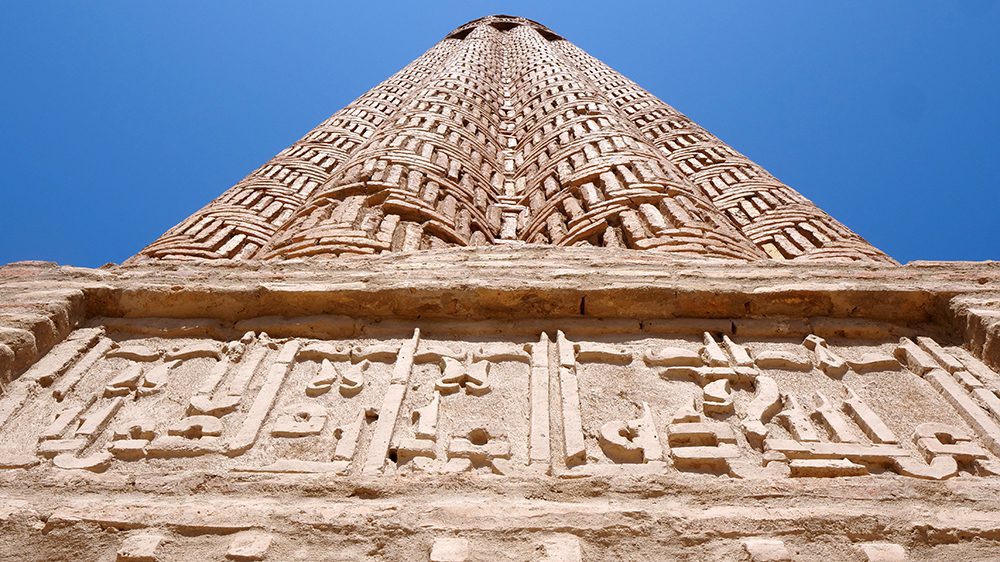
But even considerably shorter than it should have been, it is still spectacular. The minaret’s architecture is quite unique. The minaret features sixteen rounded semi-columns around its base, all of which are inlaid with intricate herringbone brickwork. Its style was only replicated in one other place, the Sultan Saodat Complex near Termez.

After you marvel at Jarkurgan Minaret from the ground, I recommend climbing it to view the area from above. The 12th-century staircase isn’t the easiest to navigate.

The stairs are tiny and the climb is steep. But once you emerge at the top, you’ll be greeted with the epic views of the town and surrounding farmland. It’s one of my favorite things to see and do in Termez and should be on every itinerary!
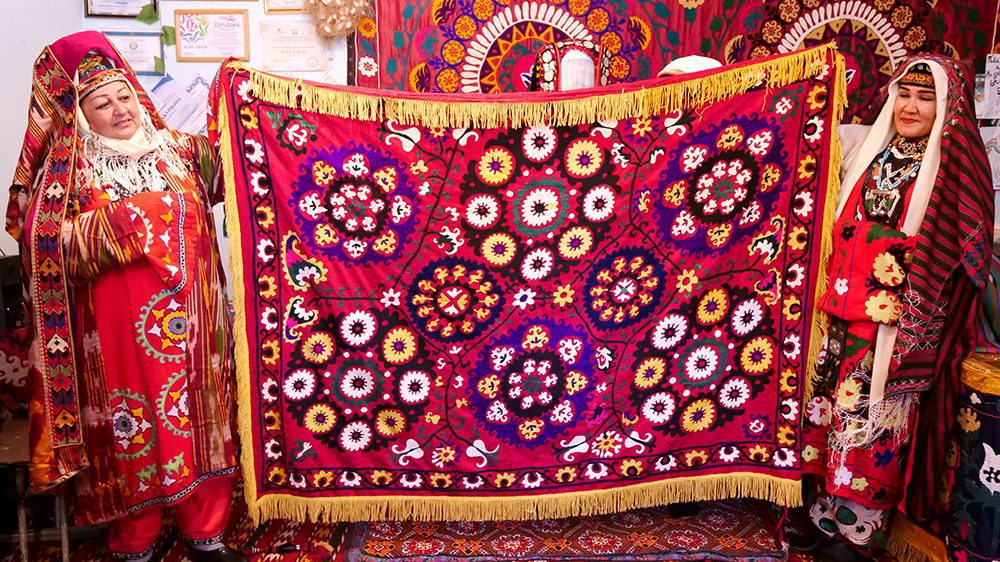
Exploring the food and history in a town like Jarkurgan without also getting a taste of the local culture is like trying to finish a jigsaw puzzle with only 75% of the pieces. You won’t get to see the complete picture, no matter how hard you try. To dive into the culture and learn about the people who call Jakurgan home, check out the town’s crafts center.

Inside, you’ll meet several women wearing bright, traditional garb and headdresses. They’ll greet you with a loaf of bread, which is the same way locals greet a visitor to their home. The women all wear different embroidery, necklaces, and headgear.
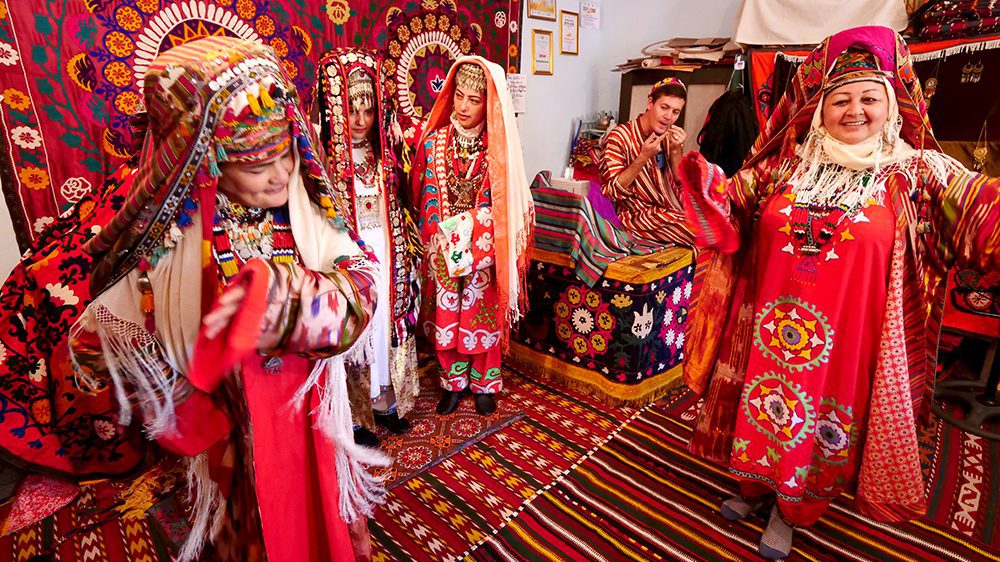
Each part of their outfit has particular meaning, and what they wear denotes where each woman is in life. Different outfits denote age, marital status, and whether or not she has had a child.

After you meet the women, you will get the rare opportunity to see them perform a traditional song and dance. On the day I visited, they performed a ceremony that they traditionally do when a bride meets her mother-in-law for the first time.

There are also men who sing and play instruments for the performances. They wear a specific head wrap, which they happily wrapped around my head before inviting me to take part in a folk music and dance performance!
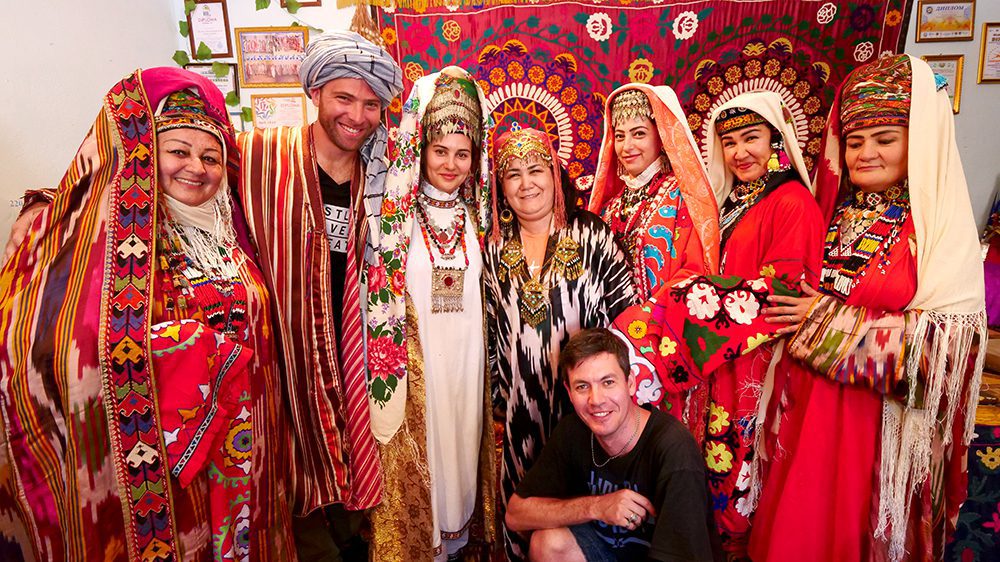
I didn’t know the words of the song, but trying to sing and dance along was a lot of fun and everyone was super kind to me!
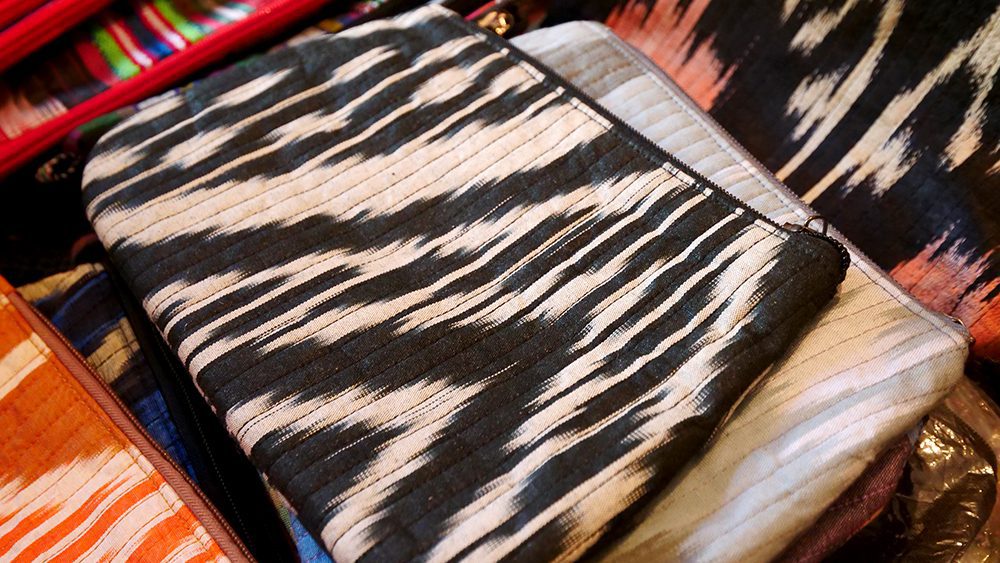
After the singing and dancing stop, I suggest buying some of the local crafts as gifts or souvenirs. I’m always happy to do so, as I know my money is going toward the locals and keeping their traditions alive.

At this shop, they made lots of different items, including carpets, clothing, and cloth ornaments for Christmas trees. The crafts center produces the material and their students make their creations at home!

Of all the things to see and do in Termez, visiting this crafts center in Jarkurgan is easily one of the best cultural experiences you can have!
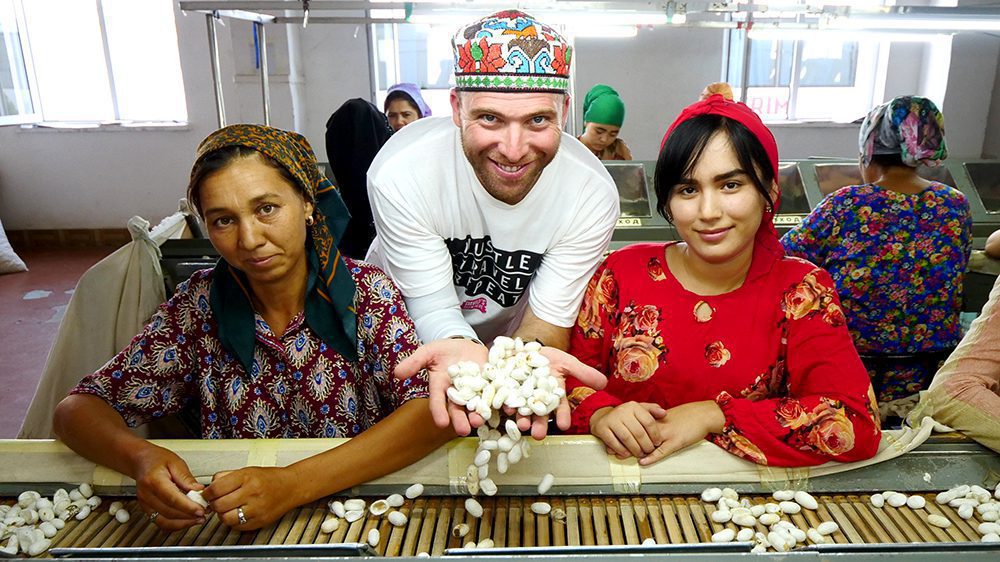
When people visit Uzbekistan, they rarely venture beyond the cities of Tashkent, Khiva, Bukhara, and Samarkand. And while those cities are noted for their rich cultural heritage and stunning historical attractions, there is more to see when you venture further south. From its old Buddhist monasteries to its divine restaurants, Termez deserves to be on every Uzbek itinerary. If you’re anything like me, you will fall in love with the people, food, and culture just like I did. Book a trip to Termez today to have your own ancient Uzbek frontier town experience!
NOTE: If you need to check the visa requirements of a particular country, click here. To apply for a visa, find up-to-date visa information for different countries, and calculate the cost of a particular visa, click here!
Counter
101 Countries • 1432 Cities
Bharat Taxi says:
Great Blog!! Thanks for sharing this good information.